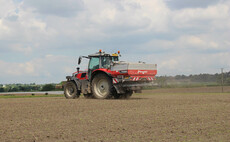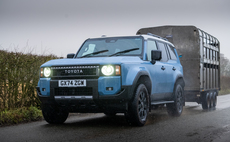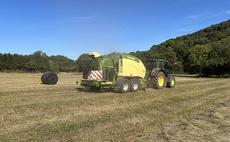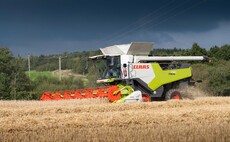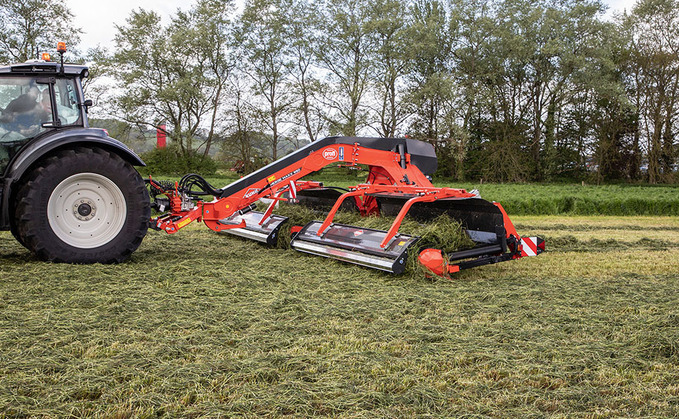
Having tried a front-mounted swath merger in an effort to improve forage quality, one contractor has made the decision to step up to a larger trailed machine for the 2019 season.
Working in the Cotswolds, D. Hunt Agricultural Contractors faces a constant battle with stones. While it is tough on his arable kit, it wreaks havoc with forage equipment. Even more so when a rake has been through the crop.
David Hunt, Middle Brookend Farm, Moreton-in-Marsh, says: "Rakes are pretty aggressive. Unless your fields are super-smooth and flat, there is always going to be some unwanted ground contact.
"We have also found rakes can damage some grass varieties. They are just not gentle enough."
He adds when it comes to grass and forage equipment, the challenges of the stony Cotswold region are something which the firm has had to accept.
"Unfortunately, the risk of forage contamination is something we and our customers have had to tolerate for years.
Blades
"To add insult to injury, forager blades, shear bars, chute liners and trailers all take a good hiding from stones and flints."
But light is now at the end of the tunnel. Three years ago, the firm bought a three-metre front mounted merger in a bid to find a gentler alternative to the rake.
"I bought it as an experiment," he says. "The principle was fantastic. It seemed a logical way forward. But at just 3m wide, it was far too slow and it did not like rougher ground. But we found ways to use it to group a couple of grass swaths, then finish off with the rake so we could just about keep ahead of the forager.
"It proved equally as useful in straw too. We bale for a straw merchant using 2270 and 2270XD six string Massey Ferguson balers, so we never know what size of combine swath we are going to get."
Output
He adds the merger helped improve baler output by doubling up smaller swaths and it also had a role to play after a shower of rain, where the merger could be used to turn straw.
"I really liked the idea of swath merging. We had noticed a big reduction in contamination of forage, but we really needed a much bigger machine."
With the 2019 grass season about to get into full swing, he has just taken delivery of a Kuhn Merge Maxx 950 supplied by local dealer Turney FieldForce, which picks up the baton from his Kuhn GA9531 twin rotor rake.
"I ordered the merger last year as soon as I saw it. It was just what we needed to improve forage quality, gently lifting the crop off the mown stubbles and placing it into a much larger row."
This latest version of the trailed Merge Maxx appeared at Grassland South West in 2018 and has adopted a simplified construction using two 4m belts, instead of its predecessor's three-belt configuration.
It offers two working widths - 7.5m and 9.5m. In its 7.5m setting, the two belts are butted together and afford left- or right-side swath positioning. This is said to be useful to group two 7.5m rows side by side on adjacent passes.
Moving to the wider 9.5m setting creates a 1.5m opening between the two belts. In this mode, belts can be operated to merge the swath into a central position. Further versatility comes from running the belts in the same direction or in opposite directions, enabling a swath to be placed on either side of the machine, or delivering one side swath and one central swath.
Pickups
Carried on the tractor's lower link arms and equipped with its own self-contained hydraulic system, this model is equipped with manual flow control of the two hydraulically driven pickups.
Operational flexibility is vast and, where grass crops are thin, it enables endless volumes of grass to be gathered up to slow the forward speed of a hungry forager. For David Hunt, that hungry forager is a 600hp New Holland FR9060.
"I did consider a four-rotor rake, but it is very much a one-trick pony," Mr Hunt says.
"Four rotor rakes are expensive, and while you can do much in late cuts to create a big swath, you will still need a twin rotor for heavier first- and second-cut grass. And in our stony region, a rake means we are still not getting away from the risks of crop contamination."
He says the forager gets a new shear bar and a full set of blades at the start of every season. And additional sets of blades are consumed as the season progresses.
"I am confident the Merge Maxx will leave stones on the ground, so blade life will improve. Running costs should be a little more palatable and customers will benefit from higher forage quality."
But the switch to high capacity merging comes at a price.
Damage
"Its ability to gently handle the crop will reduce leaf and stem damage. It just will not knock the life out of grass like a rake," he adds.
"And the less you have to handle the grass, the better the end result."
Used on a New Holland T7.245 - the smallest tractor in the fleet - Mr Hunt says the Merge Maxx will be a one-man machine.
"It is one of those units where an operator needs to spend time in the cab to learn and understand how to get the best from it. And it will need dialogue with the rest of the foraging team to decide how much grass is merged into one swath.
"This year will be an interesting season, and one I hope will bring us more customers seeking higher quality forage," he says.
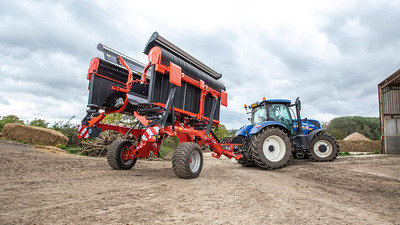
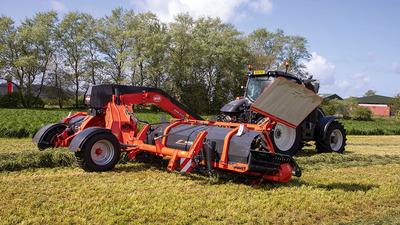
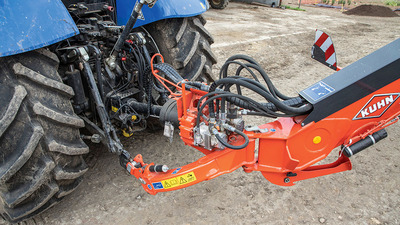
Verdict
With the ability to merge swaths to one side, to both sides or to the middle, the Merge Maxx is a winner on that count alone but with the added appeal of lifting and shifting grass in a way that minimises the risk of contamination by stones and soil and without hammering the sward.



















